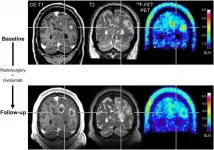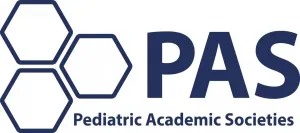(Press-News.org) Reston, VA--For patients with brain metastases, amino acid positron emission tomography (PET) can provide valuable information about the effectiveness of state-of-the-art treatments. When treatment monitoring with contrast-enhanced magnetic resonance imaging (MRI) is unclear, adding 18F-FET PET can help to accurately diagnose recurring brain metastases and reliably assess patient response. This research was published in The Journal of Nuclear Medicine.
Newer treatment options for patients with brain metastases--such as immune checkpoint inhibitors and targeted therapies--are effective, but can cause a variety of side effects. As a result, imaging findings on contrast-enhanced MRI can be highly variable, and it can be difficult to tell whether a treatment is working.
"Essentially, these new treatments have requirements of brain imaging which cannot be met by conventional MRI," said Norbert Galldiks, MD, professor of neurology, neurologist and neuro-oncologist at the University Hospital Cologne and Research Center in Juelich, Germany. "In our study, we tried to determine if adding 18F-FET PET could help to overcome some of these imaging challenges."
The retrospective study included melanoma and lung cancer patients with brain metastases who had been treated with immune checkpoint inhibitors or targeted therapy alone or in combination with radiotherapy. 18F-FET PET imaging was shown to be a useful method when conventional MRI was inconclusive. It could correctly diagnose brain metastasis relapses and identify patients who were responding to treatment and those who were not.
"In cases of ambiguous MRI findings, supplemental FET PET is helpful for treatment monitoring. It provides physicians with a longer time window for subsequent patient management and allows them to optimize the treatment strategy for each individual patient," noted Galldiks. "Since this approach is so accurate, it has the potential to influence clinical decision making. This may help to reduce the number of invasive procedures and limit overtreatment for a considerable number of seriously ill patients with brain metastases."
This study was made available online in September 2020 ahead of final publication in print in April 2021.
The authors of "Treatment Monitoring of Immunotherapy and Targeted Therapy Using 18F-FET PET in Patients with Melanoma and Lung Cancer Brain Metastases: Initial Experiences," include Norbert Galldiks, Department of Neurology, Faculty of Medicine and University Hospital Cologne, University of Cologne, Cologne, Germany, Center of Integrated Oncology, Universities of Aachen, Bonn, Cologne, and Duesseldorf, Germany, and Institute of Neuroscience and Medicine (INM-3, -4), Research Center Juelich, Juelich, Germany; Diana S.Y. Abdulla, Matthias Scheffler and Jürgen Wolf, Center of Integrated Oncology, Universities of Aachen, Bonn, Cologne, and Duesseldorf, Germany, and Lung Cancer Group, Department I of Internal Medicine, Faculty of Medicine and University Hospital Cologne, University of Cologne, Cologne, Germany; Fabian Wolpert and Michael Weller, Department of Neurology and Brain Tumor Center, University Hospital and University of Zurich, Zurich, Switzerland; Jan-Michael Werner and Gary Ceccon, Department of Neurology, Faculty of Medicine and University Hospital Cologne, University of Cologne, Cologne, Germany; Martin Hüllner, Department of Nuclear Medicine, University Hospital and University of Zurich, Zurich, Switzerland; Gabriele Stoffels, Institute of Neuroscience and Medicine (INM-3, -4), Research Center Juelich, Juelich, Germany; Viola Schweinsberg, Max Schlaak, Nicole Kreuzberg and Cornelia Mauch, Center of Integrated Oncology, Universities of Aachen, Bonn, Cologne, and Duesseldorf, Germany, and Department of Dermatology, Faculty of Medicine and University Hospital Cologne, University of Cologne, Cologne, Germany; Jennifer Landsberg, Center of Integrated Oncology, Universities of Aachen, Bonn, Cologne, and Duesseldorf, Germany, and Department of Dermatology, University Hospital Bonn, Bonn, Germany; Philipp Lohmann and Martin Kocher, Institute of Neuroscience and Medicine (INM-3, -4), Research Center Juelich, Juelich, Germany, and Department of Stereotaxy and Functional Neurosurgery, Faculty of Medicine and University Hospital Cologne, University of Cologne, Cologne, Germany; Christian Baues, Maike Trommer and Simone Marnitz, Center of Integrated Oncology, Universities of Aachen, Bonn, Cologne, and Duesseldorf, Germany, and Department of Radiation Oncology, Faculty of Medicine and University Hospital Cologne, University of Cologne, Cologne, Germany; Eren Celik and Maximillian I. Ruge, Center of Integrated Oncology, Universities of Aachen, Bonn, Cologne, and Duesseldorf, Germany, and Department of Stereotaxy and Functional Neurosurgery, Faculty of Medicine and University Hospital Cologne, University of Cologne, Cologne, Germany; Gereon R. Fink, Department of Neurology, Faculty of Medicine and University Hospital Cologne, University of Cologne, Cologne, Germany, and Institute of Neuroscience and Medicine (INM-3, -4), Research Center Juelich, Juelich, Germany; Jörg-Christian Tonn, Department of Neurosurgery, University Hospital LMU Munich, Munich, Germany; and Karl-Josef Langen, Institute of Neuroscience and Medicine (INM-3, -4), Research Center Juelich, Juelich, Germany, and Department of Nuclear Medicine, RWTH University Hospital Aachen, Aachen, Germany.
Visit JNM's new website for the latest nuclear medicine research, and follow our new Twitter and Facebook pages @JournalofNucMed.
INFORMATION:
Please visit the SNMMI Media Center for more information about molecular imaging and precision imaging. To schedule an interview with the researchers, please contact Rebecca Maxey at (703) 652-6772 or rmaxey@snmmi.org.
About JNM and the Society of Nuclear Medicine and Molecular Imaging
The Journal of Nuclear Medicine (JNM) is the world's leading nuclear medicine, molecular imaging and theranostics journal, accessed more than 11 million times each year by practitioners around the globe, providing them with the information they need to advance this rapidly expanding field. Current and past issues of The Journal of Nuclear Medicine can be found online at http://jnm.snmjournals.org.
JNM is published by the Society of Nuclear Medicine and Molecular Imaging (SNMMI), an international scientific and medical organization dedicated to advancing nuclear medicine and molecular imaging--precision medicine that allows diagnosis and treatment to be tailored to individual patients in order to achieve the best possible outcomes. For more information, visit http://www.snmmi.org.
The human immune system doesn't just protect our health, it reflects it. Each encounter with a potential disease-causing agent causes the body to produce specific immune agents -- proteins known as antibodies and T-cell receptors -- tailor-made to recognize and destroy the invader. Tasked with preventing re-infection, antibodies and T-cell receptors (TCR) from your previous encounters circulate throughout the body indefinitely, like a record of your personal medical history that you carry inside of you.
Clinical pathologist Ramy Arnaout, MD, DPhil, ...
WASHINGTON, DC -- A new case report, detailed in Annals of Emergency Medicine, is the first known case of a patient with VITT (vaccine-induced thrombotic thrombocytopenia) treated with a heparin alternative following the Centers for Disease Control and Prevention (CDC) guidance.
An otherwise healthy female patient in her 40s came to the emergency department at UCHealth University of Colorado Hospital twelve days after receiving the Johnson & Johnson vaccine with a headache, dizziness, and vision changes. The patient was treated on April 13, 2021, the same day that the Centers for Disease Control and Prevention (CDC) announced a pause in the administration of the Johnson & Johnson vaccine. CDC guidance recommended ...
You know that raw overwhelm people have been reporting after months of a pandemic, compounded by economic issues and social unrest? Does fatigue and compulsive social media scrolling strike a familiar chord?
Those brittle feelings offer us a glimpse into what regular life can be like for individuals with sensory processing sensitivity (SPS), a biological trait possessed by roughly a third of the population. In a world of constant information overload and stress, it's a characteristic that can result in a variety of behaviors, from emotional outbursts to withdrawal, overwhelm and procrastination.
"Behaviorally, we observe it as being more careful and cautious when approaching new things," said Bianca Acevedo, a researcher ...
Boulder, Colo., USA: The Geological Society of America regularly publishes
articles online ahead of print. For April, GSA Bulletin topics
include multiple articles about the dynamics of China and Tibet; the Bell
River hypothesis that proposes that an ancestral, transcontinental river
occupied much of northern North America during the Cenozoic Era; new
findings in the climatic history during one of the Earth's coldest periods:
The Late Paleozoic Ice Age; and the age an nature of the Chicxulub impact
crater. You can find these articles at END ...
PHILADELPHIA - Lung cancer is the third most common cancer in the U.S. and the leading cause of cancer death, with about 80% of the total 154,000 deaths recorded each year caused by cigarette smoking. Black men are more likely to develop and die from lung cancer than persons of any other racial or ethnic group, pointing to severe racial disparities. For example, research has shown that Black patients are less likely to receive early diagnosis and life-saving treatments like surgery. Now researchers at Jefferson have found that a commonly used risk prediction model does not accurately identify high-risk Black patients who could gain life-saving benefit from early screening, and paves the way for improving screenings and guidelines. The research was published in JAMA Network ...
A new study, published in JCI Insight, looks at how Brd4, a regulator of the innate immune response, influences diet-induced obesity. The researchers believe that Brd4 could be used as a target for obesity and insulin resistance.
Approximately one-third of the adults and one in five children in the U.S. have obesity problems. Unfortunately, the condition is also associated with the development of other diseases including diabetes, cardiovascular disorders, and cancer. "One of the biggest challenges we face is trying to understand how people develop obesity. If we can understand that, we can develop solutions for treating or preventing these diseases," said Lin-Feng Chen (MME), a professor of biochemistry.
The researchers investigated the role of the ...
The soybean cyst nematode (SCN) is the most damaging pathogen of soybean in the United States and Canada and it is spreading rapidly, according to information compiled by Gregory Tylka and Christopher Marett, nematologists at Iowa State University. SCN was first found in the United States in 1954 and most recent estimates show that SCN results in $1.5 billion in annual yield losses.
"The continuing spread of SCN is alarming, but not surprising," said Tylka. "Anything that moves soil can move the nematode, including wind, water, and farm machinery." ...
Educating athletes, parents and coaches about concussion treatment and prevention has been a priority during the last decade, but are the intended audiences hearing the message?
New research from the University of Michigan found that 1 in 4 adolescents self-reported at least one concussion in 2020, up from about 20% in 2016. During that same time period, youth who reported one concussion rose from roughly 14% to 18%, and those who reported at least two concussions increased from about 6% to 7%.
"Self-reported concussions could be increasing given that both children and parents have greater ...
Researchers at AMBER, the SFI Centre for Advanced Materials and BioEngineering Research, and from Trinity's School of Physics, have developed next-generation, graphene-based sensing technology using their innovative G-Putty material.
The team's printed sensors are 50 times more sensitive than the industry standard and outperform other comparable nano-enabled sensors in an important metric seen as a game-changer in the industry: flexibility.
Maximising sensitivity and flexibility without reducing performance makes the teams' technology an ideal candidate for the emerging areas ...
A hot topic symposia session during the Pediatric Academic Societies (PAS) 2021 Virtual Meeting will address the persistent controversies and questions in preterm infant nutrition.
After six years of interdisciplinary expert discussion and critical evidence review, the 2014 vision to develop evidence-informed guidance for the nutritional care of preterm infants has come to fruition. The Eunice Kennedy Shriver National Institute of Child Health and Human Development (NICHD) and the Academy of Nutrition and Dietetics (AND) initiated this multiphase process involving expert physician, dietitian, and pharmacology scientists.
The first phase, Pre-B, addressed the existing evidence and research ...



